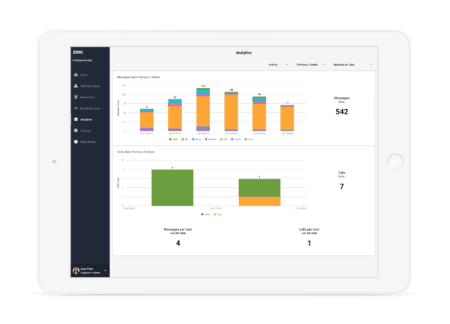Measuring Internal Communication Effectiveness in 3 Steps
If you want to improve communications and show your impact in terms of hard data, measuring internal communication effectiveness is crucial. But with teams spread out over hundreds to thousands of people, it can be hard to know where to start.
By looking at communication analytics and reviewing quarterly metrics, you can begin to track the effectiveness of company-wide communications in a quantifiable way. Here are our top 3 KPIs for how to measure internal communication effectiveness.
1. Look closer at “Delivered, Read and Click-Through Rates”
Facilitating communications and keeping everyone across the organization informed is a big task. Once important information and messages are sent, do you know if anyone is reading them?
We know that email open and read rates are dismal, as are Intranet postings. So your first step is to send content using a medium that employees will actually use and come back to. Using a mobile-first communication platform ensures you are reaching employees in a way they enjoy. Recent survey results show that 98 percent of employees in predominantly deskless roles need a communications app to conduct their work – 74 percent say it is very important.
The next step in measuring internal communication effectiveness is to track overall engagement based on your information sharing and messages. This means looking at received, open, and click-through rates to gauge how well your content is being received.
Such insights give you the ability to easily evaluate your content and create specific goals for improving open and click-through rates.

Measuring internal communication effectiveness with Zinc communication analytics.
2. Track Employee Engagement Rates
Employee engagement is discussed a lot, and it’s for a good reason. Disengaged employees costs organizations between $450 and $550 billion annually.
While there are multiple factors that impact engagement, communication is the “make it or break it” factor. To measure the success of internal communications, start by recording baseline employee engagement rates. Stephen Huerta the co-founder and CEO of Workify, a company created to help organizations improve engagement, offers suggestions for measuring engagement here.
One very popular measurement is the Employee Net Promoter Score (ENPS), adapted from the customer satisfaction measuring NPS score. The best possible ENPS score is +100, with the worst being -100. A score greater than 50 indicates that you are doing pretty well, but most companies tend to start out in the negative.
With this baseline score, you can track the effectiveness of your communications with real employee engagement rates.
>Read our full guide to motivating disengaged employees here.
3. Track Employee Turnover (or Attrition)
Similar to employee engagement, employee turnover is a costly consequence of poor organizational communication, among other factors. Josh Bersin of Deloitte estimates the cost of losing an employee can range from tens of thousands of dollars to 1.5–2.0x the employee’s annual salary.
As communications professionals know, ensuring employees feel valued, informed and connected to the organization is key to reducing turnover. Make sure to track retention rates and correlate them to your overall communication efforts in order to show how you are making a difference.
Empowering Effective Communications
How you communicate is just as important as what you use to communicate. Consistently sending out great content, whether policy updates or a video from the CEO, doesn’t matter if employees aren’t reading it.
If you are still using email or any other old-school communications systems, it’s time to consider a forward-thinking mobile-first approach. Leveraging an intuitive communication platform built for the way workers of today communicate can go a long way to improving communication effectiveness.
Kyle Christensen, the communications manager for field service at Vivint Smart Homes decided to leverage an All Mode Communication platform to help improve employee engagement, retention, and performance. After getting his team on Zinc, he saw employee engagement rates increase by 50 percent, time to service delivery drop by 37 percent, and the company’s NPS score increase into the 80s — one of the best scores in the industry.
As you start measuring these KPIs for internal communication effectiveness, ask yourself how you can encourage better communication, and lead by example. Make sure everyone knows that good internal business communication directly impacts employee satisfaction and retention as well as leads to greater productivity, better services delivery, and better customer satisfaction.


Share this: